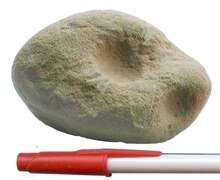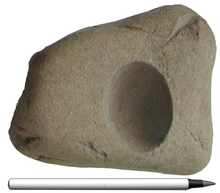Cupstone
| Cupstone, Poculolith, Pitted Cobble, Nutting stone | |
|---|---|
 A cupstone | |
| General | |
| Category | Archaeological Artifact |
Cupstones,also calledanvil stones,pitted cobblesandnutting stones,among other names, are roughlydiscoidalor amorphous groundstoneartifactsamong the most commonlithicremains ofNative Americanculture, especially in theMidwestern United States,in EarlyArchaiccontexts. The hemispherical indentation itself is an important element ofpaleoart,known as a "cupule".Cup and ring marksare also common in the Fertile Crescent and India, and later in the Mediterranean, Atlantic, and Alpine regions of Europe, sometimes associated with complexpetroglyphsormegalithic monuments.[1][clarification needed]
Etymology
[edit]One encyclopedia of archaeology treats "pitted stone", "cupstones", and "nutting stones" as synonyms and says that they "may have been formed by cracking nutshells, though this activity lacks adequate confirmation through ethnographic examples or published experimentation."[2]
Purpose
[edit]These objects have received little study, perhaps because edged tools and weapons have more intrinsic interest to private collectors, but closer study of them might reveal something of domestic practices andtoolmakingtechnology. There is no agreement upon their purpose or purposes, which may have included the processing of food, medicine or pigments, storage, arrow-production or fire-drilling. As such, they could represent a primitive form ofmortar and pestle.The age of these man-made structures is difficult to ascertain, but generally they are believed to have been produced in theBronze AgeandUpper Paleolithicalthough some, for example in North America and Europe, were generated at a later date.
Visually, they may resembleomarolluks,a naturally occurring feature of sedimentary rock occurring exclusively in theBelcher Islands,an archipelago accounting for 0.25% ofHudson Bay,whence they are thought to have been spread byglaciers.[3]
Distribution
[edit]Similar objects can be found on all continents except Antarctica. They are associated withCelticEurope, prehistoricAustralia,Borneoand theMiddle East.Some of the earliest cupules can be found at theBhimbetkacave site in India, dating to 290,000-700,000 BCE, but in Europe they do not pre-date the most recent cold phase (theWürmorWeichselian glaciation). Some scholars insist the items are "false" artifacts, that is, their form results from natural processes rather than human activity. However, no one has yet described processes that might both produce such effects and also explain the distribution of the effects and the objects. Certainly air-bubbles in stone, broken open and eroded, could produce some of these phenomena. The objects are familiar inIllinois,Ohio,Indiana,Arkansas,Kentucky,Tennessee,AlabamaandMississippi,and occur elsewhere as well.
The pattern, size and number of concavities is not predictable, nor is material—impressions are found in softsandstoneand hardgranite.Cupstones may exhibit a mixture of large and small indentations, perhaps indicating multiple uses over a considerable span of time. Indentations range from barely visible 1/16 "to 6". Examination under magnification suggests the impressions were at least in some cases formed by rotary grinding, particularly in softer rocks. In most cases, archeological evidence of cupstones on hard rock surfaces and monoliths indicates that they were created by direct percussion with rock hammers. Typical impressions are of the simple pit type, though some cavities have been excavated to produce an opened-sphere type of pocket, by means and for reasons unknown. Very large specimens weighing several tons and with dozens of impressions several inches across are thought to be cult objects; they have been found throughout theMississippi Valley.
Historic accounts
[edit]There are several ethnographic accounts of the Native use of nutting stones in the historic times.[4][5]One account says "the Virginia Indians in 1587 tells us that each household had stones for cracking nuts and for grinding shell and other materials." It goes on to say that "This statement would doubtless be equally true if applied at that time to almost any tribe inhabiting the section east of the Mississippi."[6]
InHawaii,cup and ring marks are associated with petroglyphs, and those occurring in the boundary regions of Apuki andPunalands have been used as depositories for a child's navel cord, a custom also observed in otherPolynesian peoples.[7]
Interpretation
[edit]This sectionneeds additional citations forverification.(November 2021) |
Early observers saw the processing ofmastusing stones, and one later recreation achieved similar results: nuts were placed, one at a time, on stone (an "anvil" stone) and then struck with a smaller "hammer" stone: "As nuts were cracked in this manner a pit developed in the lower stone; the pit deepened as additional nuts were cracked, and this facilitated the cracking process since nuts were held rather stationary in this 'seat.'"[8]
The most likely interpretation seems that these artifacts represent a single technique of shaping or adapting stone for multiple purposes, some unguessed (for instance, the function of the smallest pits) and that the objects could be used by single or multiple individuals over long periods of time, and for various purposes. Indeed, the apparent randomness of their distribution may indicate that they were left lying as modified natural resources, whether with benevolent intent or because they did not represent a sufficient investment of time and labor to justify transporting them ( "opportunistic" tools). More simply, perhaps the users intended to return to the same area during the next year's mast-gathering period.
The now traditional term "nutting stone" may be justified, as may "straightening stone" or "shaft-anchor" (for straightening arrow-shafts) within a larger class we might call "poculoliths" (<L. poculus, "small pocket", "cup" ). While an equivalent to "pitted stone", the proposed term has the advantage of wider comprehensibility among international scholars as the worldwide distribution of the form becomes increasingly evident.
Another interpretation of these structures is fossilization. Anatomical structures of the orbit, skull, joints, organs, antler and dental cavities are similar. Fragmentation may have occurred before or after fossilization, natural human smoothing and polishing. The structure becomes a ubiquitous, multipurpose tool for humans to exploit.
Cupstone sites in Northern Italy, Switzerland and the Atlantic regions, also known as "druid altars" or "Opferkessel" (sacrificial bowl), are associated with places of worship due their locality close toglacial erratics,view points and treacherous alpine trails. Some of the prehistoric cupstone sites north of the Alps along the Jura mountains, for example nearGrenchen,show a row of cups with possibly astronomical orientation. However, cupstones are usually not associated with calendar functions as this is sometimes the case withmenhirsandmegaliths.

Omars
[edit]Nutting stones can be very similar in appearance toomars.Omars are naturally formed stones that have hemispherical bubbles in them.
See also
[edit]References
[edit]- ^Gansser A.Cupstones, Prehistoric Cult ObjectsVerlag Dr. C. Müller-Straten, München (1999). p. 18ff.ISBN3-932704-66-5.
- ^George H. Odell, "Pitted Stones" inArchaeology of prehistoric native America: an encyclopedia,ed. Guy E. Gibbon and Kenneth M. Ames. (Privately printed in the United States, 1998), 652.
- ^Dutch, S. (n.d.)Leaverites - Features in Sedimentary RocksArchived2009-03-27 at theWayback Machine.Downloaded October 28, 2009
- ^C. Allan JonesTexas roots: agriculture and rural life before the Civil War(College Station: Texas A&M University Press, 2005), 23.
- ^Sarah H. HillWeaving new worlds: Southeastern Cherokee women and their basketry(Chapel Hill: University of North Carolina Press, 1997), 10.
- ^Earnest Hooton, "Indian Village Site and Cemetery Near Madisonville Ohio" inPapers of the Peabody Museum of American Archaeology and Ethnology, Harvard University,(Cambridge, MA: The Peabody Museum, 1922), 56.
- ^Martha Warren Beckwith.Hawaiian Mythology.University of Hawai'i Press (1970).ISBN978-0-8248-0514-2.Retrieved 14 May 2017.
- ^Talalay, Laurie Talalay, Donald R. Keller, and Patrick J. Munson, "Hickory Nuts, Walnuts, Butternuts, And Hazelnuts: Observation and Experiments Relevant to Their Aboriginal Exploitation in Eastern North America," inExperiments and Observations on Aboriginal Wild Plant Food Utilization in Eastern North America,ed. Patrick J. Munson, (Indianapolis: Indiana Historical Society, 1984), 351.

